Nguyen Van Huynh
A Hybrid Quantum-Classical Autoencoder Framework for End-to-End Communication Systems
Dec 28, 2024
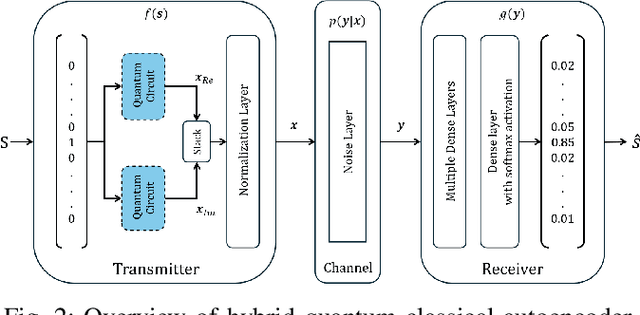
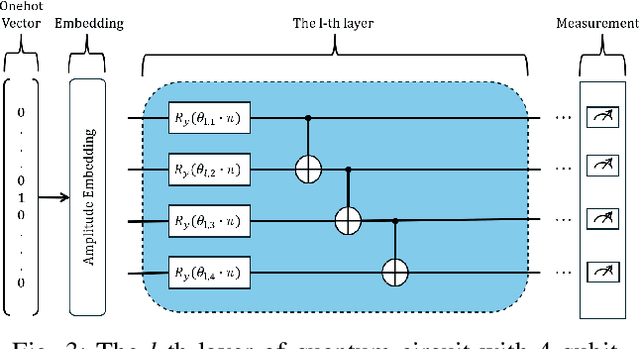

Abstract:This paper investigates the application of quantum machine learning to End-to-End (E2E) communication systems in wireless fading scenarios. We introduce a novel hybrid quantum-classical autoencoder architecture that combines parameterized quantum circuits with classical deep neural networks (DNNs). Specifically, we propose a hybrid quantum-classical autoencoder (QAE) framework to optimize the E2E communication system. Our results demonstrate the feasibility of the proposed hybrid system, and reveal that it is the first work that can achieve comparable block error rate (BLER) performance to classical DNN-based and conventional channel coding schemes, while significantly reducing the number of trainable parameters. Additionally, the proposed QAE exhibits steady and superior BLER convergence over the classical autoencoder baseline.
Dynamic Spectrum Access for Ambient Backscatter Communication-assisted D2D Systems with Quantum Reinforcement Learning
Oct 23, 2024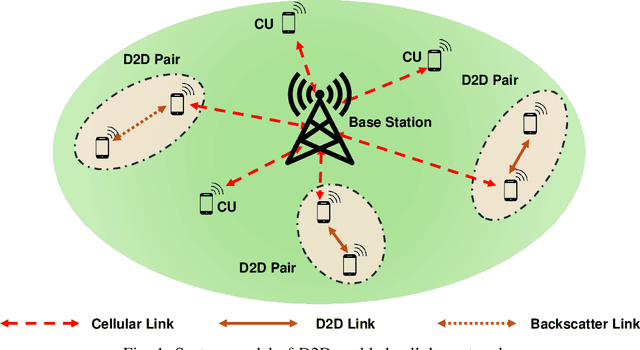
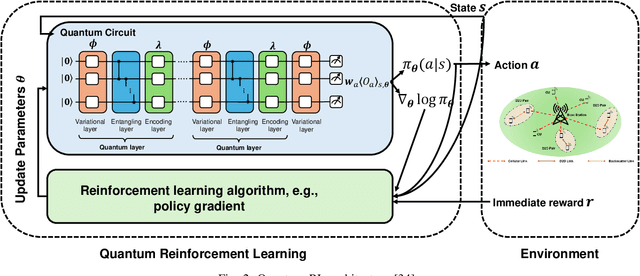
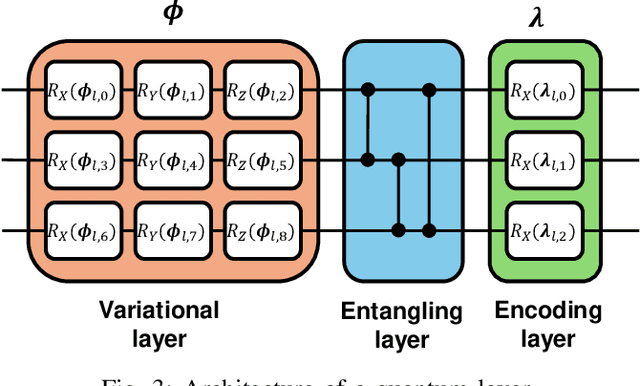
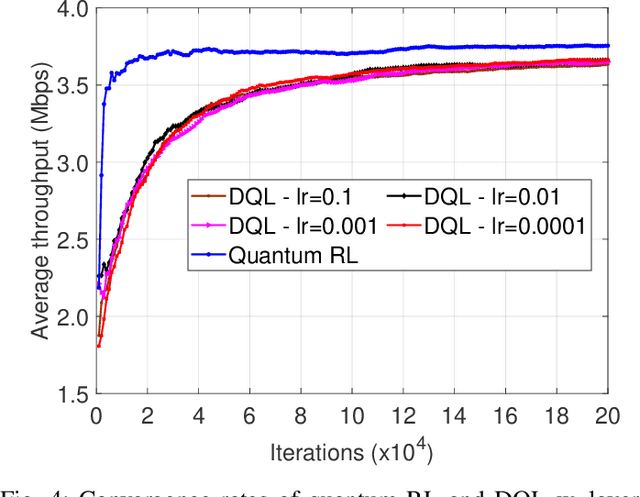
Abstract:Spectrum access is an essential problem in device-to-device (D2D) communications. However, with the recent growth in the number of mobile devices, the wireless spectrum is becoming scarce, resulting in low spectral efficiency for D2D communications. To address this problem, this paper aims to integrate the ambient backscatter communication technology into D2D devices to allow them to backscatter ambient RF signals to transmit their data when the shared spectrum is occupied by mobile users. To obtain the optimal spectrum access policy, i.e., stay idle or access the shared spectrum and perform active transmissions or backscattering ambient RF signals for transmissions, to maximize the average throughput for D2D users, deep reinforcement learning (DRL) can be adopted. However, DRL-based solutions may require long training time due to the curse of dimensionality issue as well as complex deep neural network architectures. For that, we develop a novel quantum reinforcement learning (RL) algorithm that can achieve a faster convergence rate with fewer training parameters compared to DRL thanks to the quantum superposition and quantum entanglement principles. Specifically, instead of using conventional deep neural networks, the proposed quantum RL algorithm uses a parametrized quantum circuit to approximate an optimal policy. Extensive simulations then demonstrate that the proposed solution not only can significantly improve the average throughput of D2D devices when the shared spectrum is busy but also can achieve much better performance in terms of convergence rate and learning complexity compared to existing DRL-based methods.
Applications of Generative AI for Mobile and Wireless Networking: A Survey
May 30, 2024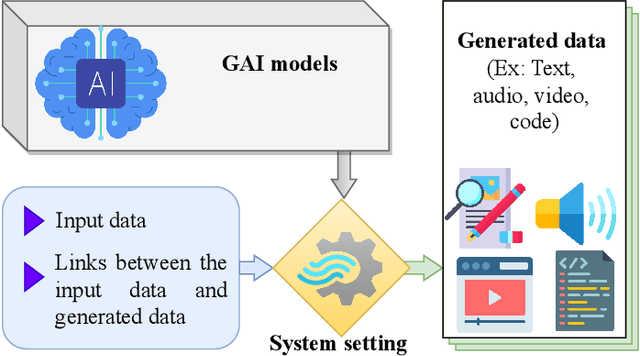
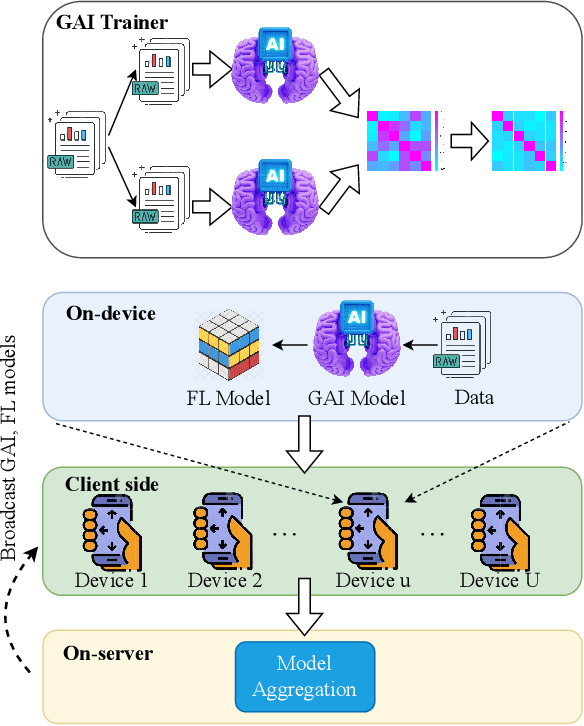

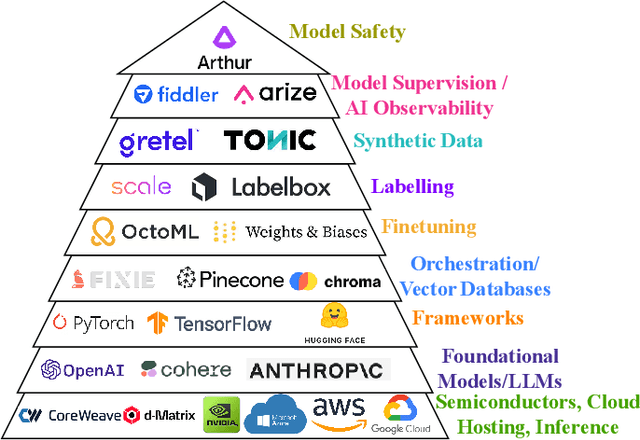
Abstract:The success of Artificial Intelligence (AI) in multiple disciplines and vertical domains in recent years has promoted the evolution of mobile networking and the future Internet toward an AI-integrated Internet-of-Things (IoT) era. Nevertheless, most AI techniques rely on data generated by physical devices (e.g., mobile devices and network nodes) or specific applications (e.g., fitness trackers and mobile gaming). To bypass this circumvent, Generative AI (GAI), a.k.a. AI-generated content (AIGC), has emerged as a powerful AI paradigm; thanks to its ability to efficiently learn complex data distributions and generate synthetic data to represent the original data in various forms. This impressive feature is projected to transform the management of mobile networking and diversify the current services and applications provided. On this basis, this work presents a concise tutorial on the role of GAIs in mobile and wireless networking. In particular, this survey first provides the fundamentals of GAI and representative GAI models, serving as an essential preliminary to the understanding of the applications of GAI in mobile and wireless networking. Then, this work provides a comprehensive review of state-of-the-art studies and GAI applications in network management, wireless security, semantic communication, and lessons learned from the open literature. Finally, this work summarizes the current research on GAI for mobile and wireless networking by outlining important challenges that need to be resolved to facilitate the development and applicability of GAI in this edge-cutting area.
A Universal Deep Neural Network for Signal Detection in Wireless Communication Systems
Apr 03, 2024Abstract:Recently, deep learning (DL) has been emerging as a promising approach for channel estimation and signal detection in wireless communications. The majority of the existing studies investigating the use of DL techniques in this domain focus on analysing channel impulse responses that are generated from only one channel distribution such as additive white Gaussian channel noise and Rayleigh channels. In practice, to cope with the dynamic nature of the wireless channel, DL methods must be re-trained on newly non-aged collected data which is costly, inefficient, and impractical. To tackle this challenge, this paper proposes a novel universal deep neural network (Uni-DNN) that can achieve high detection performance in various wireless environments without retraining the model. In particular, our proposed Uni-DNN model consists of a wireless channel classifier and a signal detector which are constructed by using DNNs. The wireless channel classifier enables the signal detector to generalise and perform optimally for multiple wireless channel distributions. In addition, to further improve the signal detection performance of the proposed model, convolutional neural network is employed. Extensive simulations using the orthogonal frequency division multiplexing scheme demonstrate that the bit error rate performance of our proposed solution can outperform conventional DL-based approaches as well as least square and minimum mean square error channel estimators in practical low pilot density scenarios.
Generative AI for Unmanned Vehicle Swarms: Challenges, Applications and Opportunities
Feb 28, 2024



Abstract:With recent advances in artificial intelligence (AI) and robotics, unmanned vehicle swarms have received great attention from both academia and industry due to their potential to provide services that are difficult and dangerous to perform by humans. However, learning and coordinating movements and actions for a large number of unmanned vehicles in complex and dynamic environments introduce significant challenges to conventional AI methods. Generative AI (GAI), with its capabilities in complex data feature extraction, transformation, and enhancement, offers great potential in solving these challenges of unmanned vehicle swarms. For that, this paper aims to provide a comprehensive survey on applications, challenges, and opportunities of GAI in unmanned vehicle swarms. Specifically, we first present an overview of unmanned vehicles and unmanned vehicle swarms as well as their use cases and existing issues. Then, an in-depth background of various GAI techniques together with their capabilities in enhancing unmanned vehicle swarms are provided. After that, we present a comprehensive review on the applications and challenges of GAI in unmanned vehicle swarms with various insights and discussions. Finally, we highlight open issues of GAI in unmanned vehicle swarms and discuss potential research directions.
Securing MIMO Wiretap Channel with Learning-Based Friendly Jamming under Imperfect CSI
Dec 12, 2023



Abstract:Wireless communications are particularly vulnerable to eavesdropping attacks due to their broadcast nature. To effectively deal with eavesdroppers, existing security techniques usually require accurate channel state information (CSI), e.g., for friendly jamming (FJ), and/or additional computing resources at transceivers, e.g., cryptography-based solutions, which unfortunately may not be feasible in practice. This challenge is even more acute in low-end IoT devices. We thus introduce a novel deep learning-based FJ framework that can effectively defeat eavesdropping attacks with imperfect CSI and even without CSI of legitimate channels. In particular, we first develop an autoencoder-based communication architecture with FJ, namely AEFJ, to jointly maximize the secrecy rate and minimize the block error rate at the receiver without requiring perfect CSI of the legitimate channels. In addition, to deal with the case without CSI, we leverage the mutual information neural estimation (MINE) concept and design a MINE-based FJ scheme that can achieve comparable security performance to the conventional FJ methods that require perfect CSI. Extensive simulations in a multiple-input multiple-output (MIMO) system demonstrate that our proposed solution can effectively deal with eavesdropping attacks in various settings. Moreover, the proposed framework can seamlessly integrate MIMO security and detection tasks into a unified end-to-end learning process. This integrated approach can significantly maximize the throughput and minimize the block error rate, offering a good solution for enhancing communication security in wireless communication systems.
Generative AI for Physical Layer Communications: A Survey
Dec 09, 2023Abstract:The recent evolution of generative artificial intelligence (GAI) leads to the emergence of groundbreaking applications such as ChatGPT, which not only enhances the efficiency of digital content production, such as text, audio, video, or even network traffic data, but also enriches its diversity. Beyond digital content creation, GAI's capability in analyzing complex data distributions offers great potential for wireless communications, particularly amidst a rapid expansion of new physical layer communication technologies. For example, the diffusion model can learn input signal distributions and use them to improve the channel estimation accuracy, while the variational autoencoder can model channel distribution and infer latent variables for blind channel equalization. Therefore, this paper presents a comprehensive investigation of GAI's applications for communications at the physical layer, ranging from traditional issues, including signal classification, channel estimation, and equalization, to emerging topics, such as intelligent reflecting surfaces and joint source channel coding. We also compare GAI-enabled physical layer communications with those supported by traditional AI, highlighting GAI's inherent capabilities and unique contributions in these areas. Finally, the paper discusses open issues and proposes several future research directions, laying a foundation for further exploration and advancement of GAI in physical layer communications.
Deep Deterministic Policy Gradient for End-to-End Communication Systems without Prior Channel Knowledge
May 12, 2023



Abstract:End-to-End (E2E) learning-based concept has been recently introduced to jointly optimize both the transmitter and the receiver in wireless communication systems. Unfortunately, this E2E learning architecture requires a prior differentiable channel model to jointly train the deep neural networks (DNNs) at the transceivers, which is hardly obtained in practice. This paper aims to solve this issue by developing a deep deterministic policy gradient (DDPG)-based framework. In particular, the proposed solution uses the loss value of the receiver DNN as the reward to train the transmitter DNN. The simulation results then show that our proposed solution can jointly train the transmitter and the receiver without requiring the prior channel model. In addition, we demonstrate that the proposed DDPG-based solution can achieve better detection performance compared to the state-of-the-art solutions.
Distributed-Training-and-Execution Multi-Agent Reinforcement Learning for Power Control in HetNet
Dec 15, 2022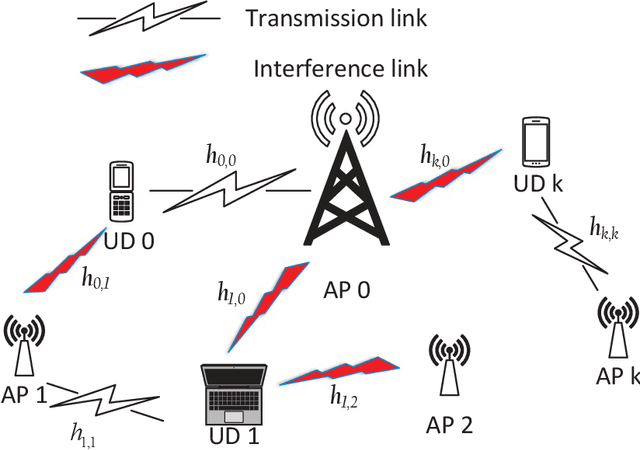
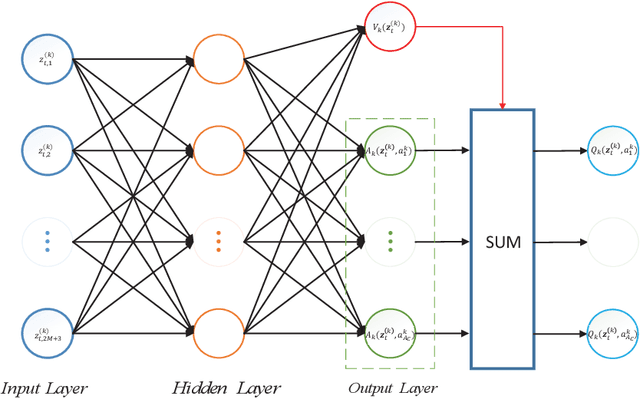


Abstract:In heterogeneous networks (HetNets), the overlap of small cells and the macro cell causes severe cross-tier interference. Although there exist some approaches to address this problem, they usually require global channel state information, which is hard to obtain in practice, and get the sub-optimal power allocation policy with high computational complexity. To overcome these limitations, we propose a multi-agent deep reinforcement learning (MADRL) based power control scheme for the HetNet, where each access point makes power control decisions independently based on local information. To promote cooperation among agents, we develop a penalty-based Q learning (PQL) algorithm for MADRL systems. By introducing regularization terms in the loss function, each agent tends to choose an experienced action with high reward when revisiting a state, and thus the policy updating speed slows down. In this way, an agent's policy can be learned by other agents more easily, resulting in a more efficient collaboration process. We then implement the proposed PQL in the considered HetNet and compare it with other distributed-training-and-execution (DTE) algorithms. Simulation results show that our proposed PQL can learn the desired power control policy from a dynamic environment where the locations of users change episodically and outperform existing DTE MADRL algorithms.
A Novel Covert Communication Method using Ambient Backscatter Communications
Jan 17, 2022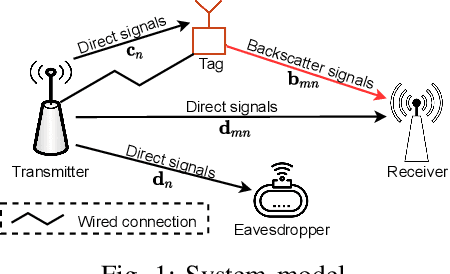
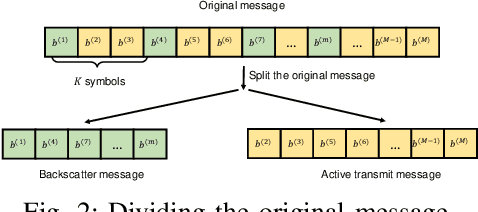
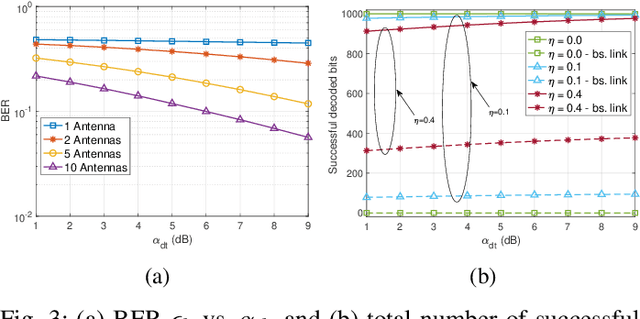
Abstract:This paper introduces a novel solution to enable covert communication in wireless systems by using ambient backscatter communication technology. In the considered system, the original message at the transmitter is first divided into two parts: (i) active transmit message and (ii) backscatter message. Then, the active transmit message is transmitted by using the conventional wireless transmission method while the backscatter message is transmitted by backscattering the active transmit signals via an ambient backscatter tag. As the backscatter tag does not generate any active signals, it is intractable for the adversary to detect the backscatter message. Therefore, secret information, e.g., secret key for decryption, can be carried by the backscattered message, making the adversary unable to decode the original message. Simulation results demonstrate that our proposed solution can help to significantly enhance security protection for communication systems.
 Add to Chrome
Add to Chrome Add to Firefox
Add to Firefox Add to Edge
Add to Edge